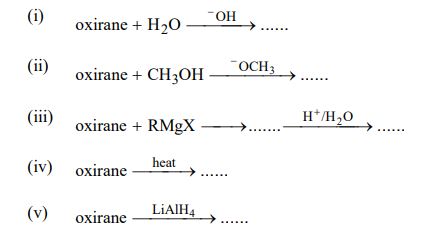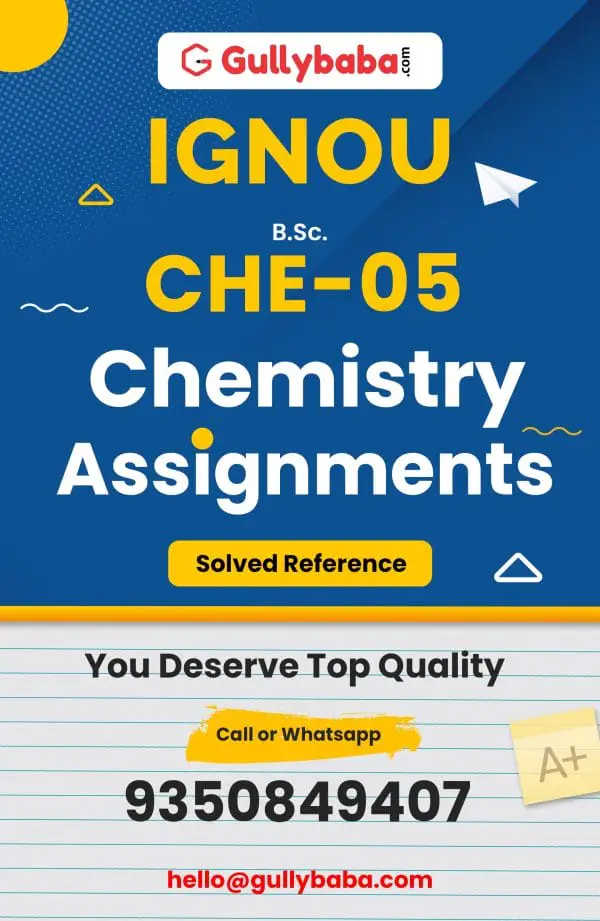PLEASE MATCH YOUR ASSIGNMENT QUESTIONS ACCORDING TO YOUR SESSION
IGNOU CHE-05 (January 2025 – December 2025) Assignment Questions
1. (a) Give the IUPAC names of the following compounds:
(b) Give the structure of the following compounds:
(i) 1, 3-Cyclohexadiene
(ii) N-methylcyclohexanamine
2. Draw various stereoisomers of 2, 3-pentanediol and classify them as enantiomers or disastereomers.
3. Draw the potential energy diagram for the conformations of n-butane. Compare the stabilities of the important conformations.
4. Differentiate between intermolecular and intramolecular hydrogen bonding giving suitable examples.
5. Arrange the following in the increasing order of their acid strengths:
Chloroethanoic acid, fluoroethanoic acid, propanoic acid. Give reason in support of your answer.
6. (a) How can cyclopentane be prepared from hexanedioic acid?
(b) How would you prepare alkanes from the following? (Give only one example).
(i) Alkyl halide
(ii) Carboxylic acid
(c) Explain the following:
(i) In the mass spectra, alkanes give a series of peaks separated by 14 mass units.
ii) Alkanes with odd number of carbon atoms have lower melting points than those with an even number of carbon atoms.
7. (a) Addition reactions of alkenes are exothermic processes. Explain.
(b) An alkene having molecular formula C6H12 an ozonolysis yielded butanal and ethanal. What is the structural formula of alkene
(c) Complete the following reactions
8. (a) Arrange the following bases in increasing order of basic strength and give reason for your answer
(b) How would you prepare the following?
(i) 3-Octyne from 1-hexyne
(ii) cis-3-Hexene from 3-hexyne
9. (a) Why does nitrobenzene not undergo Friedel-Crafts alkylation?
(b) What do you understand by para-directing activators, para-directing deactivators and meta-directing deactivators?
(c) What is Huckel’s rule? Which of the following compound(s) is aromatic? Justify your answer.
(i) Cycloctatatraene
(ii) Nitrobenzene
10. (a) Predict the major and minor products of the following reactions:
(i) Friedel-Crafts acylation of pyrrole
(ii) Friedel-Crafts alkylation of pyridine
(b) Write the structure of 3-methyl-1,3-thiozol.
(c) Explain the following:
(i) 2-Position in furan is more reactive than the 3-position towards electrophilic substitution
(ii) Pyrrole is more basic than pyridine.
11. Among alkyl halides, order of reactivity of SN2 reaction is
CH3X > p-RX > Sec-RX > tert-RX
Discuss the factors which are mainly responsible for this order.
12. Write the chemical equation for following named reactions:
a) Reimer-Tiemann reaction
b) Kolbe reaction
c) Claisen reaction
d) Knoevenagel reaction
e) Willgerodt reaction
13. Suggest the reaction that can best be used to prepare following ethers by Williamson ether synthesis
(a) CH3CH2-O-CH=CH2
14. Write the mechanism for the haloform reaction.
15. Explain Hell-Vollhard-Zelinski reaction. Also illustrate its synthetic importance.
16. Write chemical reactions for the following:
(i) Kolbe Schmidt reaction
(ii) Strecker synthesis
(iii) Dieckmann cobndensation
(iv) Knoevenagel reaction
(v) Perkin condensation
17. Discuss various methods of reduction of esters giving the products formed.
18. (a) Why do nitro compounds dissolve in sodium hydroxide?
(b) What is aci form of nitroethane? Discuss.
19. Match the following ions with their correct pKa values and give reasons for your answer
20. What are nucleotides? Draw the structures of nucleotides present in DNA and give their names.
IGNOU CHE-05 (January 2024 – December 2024) Assignment Questions
1. (a) Give the IUPAC names of the following compounds:

(b) Write the structure of the following compounds:
(i) Pentanedinitrile
(ii) N-ethyl-N-propylpropanamine
2. Discuss the optical activity of the following molecules giving suitable diagrams.
(i) trans-dichloroethene
(ii) meso-tartaric acid
3. Draw the conformations of 1,3-dimethylcyclohexane. Which of these conformations is more stable and why?
4. Draw the possible modes of vibrations of CH2 group present a molecule.
5. Briefly explain the guidelines/ rules to predict the relative importance of resonance structures in different molecules/species of organic compounds.
6. Define octane number. What are different factors affecting the octane number of a compound.
Give examples of additives used to increase the octane number.
7. What is Witting reactions? Give the mechanism of this reaction.
8. (a) How can you distinguish between terminal and internal alkynes using IR spectrum?
(b) How can you convert butane to 2-butyne.
9. Which position of naphthalene is more active towards electrophilic substitution? Explain giving suitable structures.
10. (a) Give any two methods of preparations of pyrrole. Also write the reactions involved.
(b) Write the resonance structures of pyridine-N-oxide.
11. Discuss the reactivity of allylic and benzylic halides in nucleophilic substitution reactions.
12. (a) How will you prepare phenol from benzene? Give the sequence of the reactions involved.
(b) Give the preparation and use of nitroglycerin.
13. Write the products of the following reactions of epoxides:

14. Write chemical reactions for the following named reactions:
(i) Etard’s reaction
(ii) Gattermann-Koch synthesis
(iii) Gattermann synthesis
(iv) Wacker process
(v) Friedel-Crafts acylation
15. Write chemical equations and reaction conditions for any five methods of preparation of carboxylic acids.
16. What is Michael addition? Explain giving suitable example and the mechanism involved.
17. Discuss the reduction of alknoyl halides using different reagents. Write the reactions involved and the products formed.
18. (i) Explain Henry reaction by giving a suitable example.
(ii) Write important uses of nitro compounds giving suitable examples.
19. How will you differentiate between primary, secondary and tertiary amines using nitrosation reaction?
20. Discuss the structure of starch giving the type of bonding and the components.










